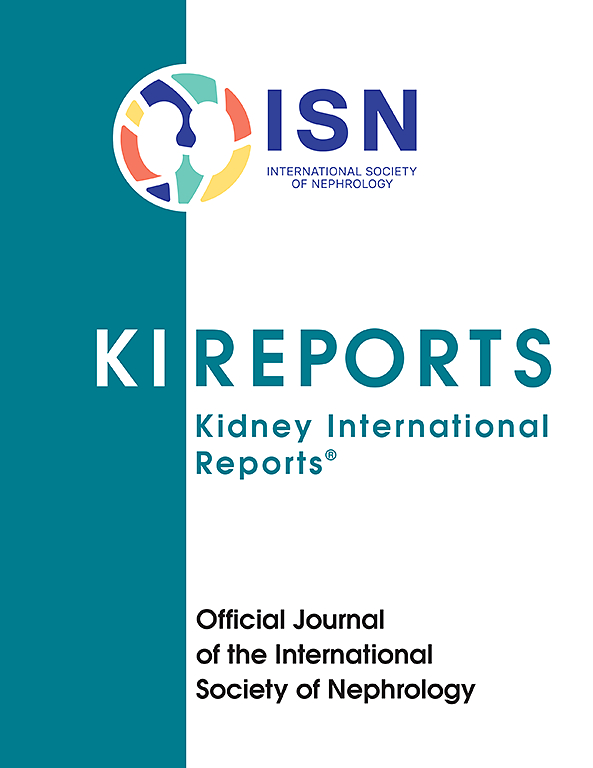使用临床和病理数据进行肾脏单克隆γ病变风险分层的机器学习
IF 5.7
2区 医学
Q1 UROLOGY & NEPHROLOGY
引用次数: 0
摘要
提示单克隆伽玛病的肾脏意义(MGRS)的检测是临床相关的化疗的开始。尽管临床和实验室数据可以提示MGRS的存在,肾活检仍然是金标准,尽管不总是进行或最终推迟,因为它被认为没有用处或信息。在这项回顾性研究中,机器学习(ML)被用来建立一个工具,以协助MGRS的活检前风险分层,并加强组织学检查的理由。方法本研究共纳入258例意义不明的单克隆伽玛病患者,根据最终肾活检结果,其中MGRS患者168例(65%),非MGRS患者90例(35%)。结果MGRS患者中女性多见(48.2%比28.9%,P = 0.004), Bence Jones蛋白尿多见(73.2%比41.1%,P <;0.001)比非mgrs病例多,淀粉样变是最常见的诊断(62%)。在验证集中,ML模型的准确率为0.79(95%置信区间[CI]: 0.67-0.88),接受者工作特征曲线下面积为0.80 (95% CI: 0.65-0.93)。该模型是一个免费的桌面和Android移动应用程序(MGRS Interactive Resource for AI-Guided Evaluation, MIRAGE)。结论基于ml的MGRS风险分层工具可以帮助筛选肾活检中MGRS发生概率较高的患者,指导患者对疾病进行完整的组织学表征。本文章由计算机程序翻译,如有差异,请以英文原文为准。

Machine Learning for Monoclonal Gammopathies of Renal Significance Risk Stratification Using Clinical and Pathology Data
Introduction
The prompt detection of monoclonal gammopathies of renal significance (MGRS) is clinically relevant for the initiation of chemotherapy. Although clinical and laboratory data can suggest the presence of MGRS, renal biopsy still represents the gold standard, despite not always being performed or eventually postponed because it is not deemed useful or informative. In this retrospective study, machine learning (ML) is used to build a tool to assist the prebiopsy risk stratification of MGRS and reinforce the rationale for the histological examination.
Methods
The study included a total of 258 patients with monoclonal gammopathy of undetermined significance, of which 168 MGRS cases (65%) and 90 non-MGRS cases (35%) based on the final renal biopsy result.
Results
Patients with MGRS were more frequently female (48.2% vs. 28.9%, P = 0.004) and had more frequent Bence Jones proteinuria (73.2% vs. 41.1%, P < 0.001) than non-MGRS cases, with amyloidosis being the most common diagnosis (62%). The ML model achieved an accuracy of 0.79 (95% confidence interval [CI]: 0.67–0.88) and an area under the receiver operating characteristic curve of 0.80 (95% CI: 0.65–0.93) in the validation set. The model is available as a free desktop and Android mobile app (MGRS Interactive Resource for AI-Guided Evaluation, MIRAGE).
Conclusion
The ML-based MGRS risk stratification tool can help in the selection of patients with higher probability to have MGRS on renal biopsy, aiming to direct those patients to a complete histological characterization of the disease.
求助全文
通过发布文献求助,成功后即可免费获取论文全文。
去求助
来源期刊

Kidney International Reports
Medicine-Nephrology
CiteScore
7.70
自引率
3.30%
发文量
1578
审稿时长
8 weeks
期刊介绍:
Kidney International Reports, an official journal of the International Society of Nephrology, is a peer-reviewed, open access journal devoted to the publication of leading research and developments related to kidney disease. With the primary aim of contributing to improved care of patients with kidney disease, the journal will publish original clinical and select translational articles and educational content related to the pathogenesis, evaluation and management of acute and chronic kidney disease, end stage renal disease (including transplantation), acid-base, fluid and electrolyte disturbances and hypertension. Of particular interest are submissions related to clinical trials, epidemiology, systematic reviews (including meta-analyses) and outcomes research. The journal will also provide a platform for wider dissemination of national and regional guidelines as well as consensus meeting reports.
 求助内容:
求助内容: 应助结果提醒方式:
应助结果提醒方式:


